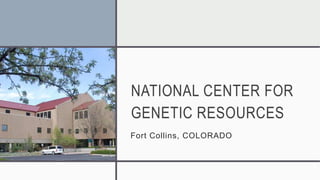
National Center for Genetic Resources Fort Collins.pptx
- 1. NATIONAL CENTER FOR GENETIC RESOURCES Fort Collins, COLORADO
- 2. CONTENTS • Introduction • History • Seeds • Clonal Germplasm • Animals
- 3. INTRODUCTION The National Center for Genetic Resources Preservation (NCGRP), part of USDA's Agricultural Research Service (ARS), maintains the genetic diversity of the world's crops and livestock as living germplasm that is distributed nationally and internationally to improve agricultural productivity, fight hunger, improve nutrition, reduce pesticide use and restore ecosystems. Strategic Objectives: – Preservation – Research – Information Management – Partnerships
- 4. HISTORY • 1890s: Genebanking in the US officially began in the 1890s with the establishment of Plant Introduction Stations around the country to evaluate plants with interesting traits. The first "official" plant introduction (PI) was a cabbage (Brassica oleraceae) from Siberia. • 1958: The National Seed Storage Laboratory (NSSL) was built in Fort Collins, Colorado to consolidate plant collections from PI stations • 1977: Seed storage vaults were converted from refrigerators (5’C) to freezers (-18’C) • 1990: Application of the modern cryopreservation tanks. Preservation of vegetative cuttings and recalcitrant seeds was now possible with the cryopreservation facilities at NSSL.
- 5. HISTORY • 1992: The NSSL building was expanded and the capacity to store germplasm increased ten-fold. • 1992: The first clonal plant propagules were placed in liquid nitrogen storage; a few years later, cryopreservation of selected clonally propagated plants was standard procedure. • 1999: USDA's first animal genebank, the National Animal Germplasm Program (NAGP), was initiated. • 2002: Name change to the National Center for Genetic Resources Preservation (NCGRP) • 2009: The preservation of plant-associated microbes became part of the NCGRP mission.
- 6. SEEDS PRESERVATION WHY to Preserve: – Climate change – The spread of new Diseases – Destructive pests – Abiotic stresses (drought and salinity)
- 7. PRESERVING GENETIC RESOURCES • Seeds are packaged in moisture proof foil bags for cold vault storage (-18°C; 0°F). • Cryogenically (liquid nitrogen, -196°C; -320°F) stored seeds are sealed in polyolefin tubes. • The testing and storage protocols developed at NCGRP are shared with other researchers and genebanks and expertise is used worldwide.
- 8. SEEDS PRESERVATION There are 29,951 unique organizations or individuals who have contributed or requested seeds from about 82 countries, including rare or endangered collections from 22 botanical gardens.
- 9. SEEDS PRESERVATION Crop Accessions (unique samples) stored at NCGRP* Corn 15,264 Wheat 59,442 Beans 12,587 Sorghum 44,151 Rice 18,313 Cotton 6,203 * as of 2013
- 10. GRIN Global Information about them is stored in a data management system called the Germplasm Resources Information Network (GRIN Global). Researchers worldwide can view collections online and order germplasm without cost by going to www.ars-grin.gov/npgs
- 11. ACQUIRING GENETIC RESOURCES 1. Seeds are acquired from the National Plant Germplasm System (NPGS). (Twenty-five field stations around the U.S. are responsible for growing specific crops to produce seed. The harvested seed is then sent here for long-term preservation.) 2. NCGRP also receive seeds from all over the United States and the world through foreign governments, public institutions and non-governmental organizations, companies, and other U.S. agencies. 3. NCGRP has duplicate collections from other genebanks as a back-up security measure.
- 12. EVALUATING GENETIC RESOURCES • When seeds arrive at NCGRP they are equilibrated (brought to a moisture content appropriate for storage) and tested for moisture content. • Seeds are evaluated for viability (tested for germination or dormancy) before and during storage.
- 13. SUCCESS STORY In the 1980’s the Russian wheat aphid became a serious pest causing over a billion dollars in direct and indirect losses. Researchers and breeders have screened varieties in NCGRP collection and discovered ten different genes that help confer resistance to the Russian wheat aphid.
- 14. CLONAL GERMPLASM WHY to Preserve: Apples, bananas, blueberries, cacao, cherries, grapes, oranges, peaches, pineapples, potatoes, strawberries, sugarcane, sweet potatoes, walnuts and many other plants are preserved by clonal propagation. Preserving clonally propagated genetic resources ensures their availability for future replanting, breeding and research when unpredicted events as weather disasters, pest and disease infestation or climate change occur.
- 15. CLONAL GERMPLASM To back-up these crops, freeze and store certain types of plant tissues (as shoot, root, stem fragment, dormant bud or somatic embryo) in liquid nitrogen which can be cloned once the tissue is revived. Scientists and researchers from other countries receive training at NCGRP in cryopreservation of clonally propagated plant species aiding in development of international genebanks and increasing worldwide protection of agricultural crops.
- 16. ACQUIRING CLONAL GERMPLASM NCGRP acquire plant tissue (as in vitro culture, dormant winter buds or immature flower buds) from the National Plant Germplasm System (NPGS). There are 12 NPGS stations around the U.S that are responsible for maintaining specific clonal crops. The stations provide plant material for long -term preservation based on an established priority list.
- 17. PRESERVING CLONAL GERMPLASM Plant samples that are cryopreserved to the lab standard are placed in cryotanks (liquid nitrogen, -196C; -320F) for a long-term storage. Currently approximately 12 percent of the NPGS clonally propagated germplasm is backed-up in liquid nitrogen. Genotypes that do not survive in viable numbers are the subject of research on optimizing pre- and post-liquid nitrogen treatment.
- 18. CLONAL GERMPLASM; Success Story After a loss due to disease, over 100 unique apple samples (accessions) were re-grafted from cryopreserved dormant buds and the apple cultivars were restored for propagation.
- 19. ANIMAL GENETIC RESOURCES National Animal Germplasm Program (NAGP) use an integrated approach comprised of inf ormation systems, g enetics and cryobiology along with interaction with national and international partners to address these issues. NAGP is the one of the world’s largest animal gene bank s with over 760,618 samples (semen, embryos, ovaries, blood), f rom 21,394 individuals f rom 33 species. Over 200 breeds and industrial populations are represented in the collection.